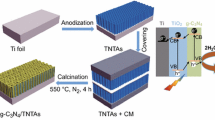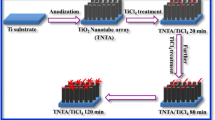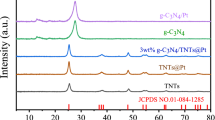Abstract
Vertically oriented titanium dioxide nanotube arrays (TNTAs) decorated with NiO nanoparticles (NPs) were successfully fabricated using two-step electrochemical anodization. An ultrasound-assisted deposition method was used to homogeneously loading the NiO NPs into the TNTAs, resulting in a NiO/TNTAs junction electrode. X-ray diffraction reveals that the TNTAs and NiO/TNTAs showed anatase structures. Also, SEM images confirm that the nanotubes have a nominal length of 3.57 µm and approximately equal wall thickness and diameters; 55.51 nm and 17.64 nm, respectively. The NiO/TNTAs junction electrode exhibited high visible light photo-response that enhances the photoelectrochemical activity. Accordingly, the incident photon-to-current conversion efficiency of NiO/TNTAs was estimated to be 86.89% in comparison to the pure TNTAs whose efficiency was equal to 29.62%. In conclusion, the NiO/TNTAs junction fabricated by a simple, cost-effective, and applicable cell is a promising clean renewable source for the water-splitting applications.










Similar content being viewed by others
References
M. Ge et al., A review of TiO2 nanostructured catalysts for sustainable H2 generation. Intl. J. Hydrogen Energy 42(12), 8418–8449 (2017)
E.P. Melián et al., Influence of nickel in the hydrogen production activity of TiO2. Appl. Catal. B 152, 192–201 (2014)
S. Shafiee, E. Topal, When will fossil fuel reserves be diminished? Energy Policy 37(1), 181–189 (2009)
A.M. Abdalla et al., Hydrogen production, storage, transportation and key challenges with applications: a review. Energy Conv. Manage 165, 602–627 (2018)
Y. Miseki, K. Sayama, Photocatalytic water splitting for solar hydrogen production using the carbonate effect and the Z-scheme reaction. Adv. Energy Mater. 9(23), 1801294 (2019)
A. Landman et al., Photoelectrochemical water splitting in separate oxygen and hydrogen cells. Nat. Mater. 16(6), 646 (2017)
R.M. Navarro et al., Hydrogen Production from Renewables. Encyclopedia of Inorganic Chemistry, 2006
C. Acar, I. Dincer, Impact assessment and efficiency evaluation of hydrogen production methods. Intl. J. Energy Res. 39(13), 1757–1768 (2015)
A. Haryanto et al., Current status of hydrogen production techniques by steam reforming of ethanol: a review. Energy Fuels 19(5), 2098–2106 (2005)
E. Üzer et al., Vapor deposition of semiconducting phosphorus allotropes into TiO2 nanotube arrays for photoelectrocatalytic water splitting. ACS Appl. Nano Mater. 2(6), 3358–3367 (2019)
M. Wang, L. Chen, L. Sun, Recent progress in electrochemical hydrogen production with earth-abundant metal complexes as catalysts. Energy Environ. Sci. 5(5), 6763–6778 (2012)
D. Merki et al., Amorphous molybdenum sulfide films as catalysts for electrochemical hydrogen production in water. Chem. Sci. 2(7), 1262–1267 (2011)
X. Chen et al., Semiconductor-based photocatalytic hydrogen generation. Chem. Rev. 110(11), 6503–6570 (2010)
A. Fujishima, K. Honda, Electrochemical photolysis of water at a semiconductor electrode. Nature 238(5358), 37–38 (1972)
C. Shifu et al., Preparation and activity evaluation of p–n junction photocatalyst NiO/TiO2. J. Hazard. Mater. 155(1–2), 320–326 (2008)
R.A. Solano et al., Fe-TiO2 nanoparticles synthesized by green chemistry for potential application in waste water photocatalytic treatment. J. Nanotechnol. (2019). https://doi.org/10.1155/2019/4571848
X. Kang et al., Titanium dioxide: from engineering to applications. Catalysts 9(2), 191 (2019)
M.E. Ali et al., Photoassisted mineralization of remazole red F3B over NiO/TiO2 and CdO/TiO2 nanoparticles under simulated sunlight. Sep. Sci. Technol. 53(1), 170–180 (2018)
M. Zhang et al., Enhanced H2 evolution of TiO2 with efficient multiple electrons transfer modified by tiny CuOx–NiO bimetallic oxides. Int. J. Hydrogen Energy 43(17), 8313–8322 (2018)
H. Gong, Q. Liu, C. Huang, NiSe as an effective co-catalyst coupled with TiO2 for enhanced photocatalytic hydrogen evolution. Int. J. Hydrogen Energy 44(10), 4821–4831 (2019)
T. Li et al., Photoelectrochemical water splitting properties of Ti-Ni-Si-O nanostructures on Ti-Ni-Si alloy. Nanomaterials 7(11), 359 (2017)
H. Li et al., Constructing stable NiO/N-doped TiO2 nanotubes photocatalyst with enhanced visible-light photocatalytic activity. J. Mater. Sci.: Mater. Electron. 26(4), 2571–2578 (2015)
M. Lorenzetti et al., Photoinduced properties of nanocrystalline TiO2-anatase coating on Ti-based bone implants. Mater. Sci. Eng. C 37, 390–398 (2014)
D. Ding, C. Ning, X. Wang, Reduced N/Ni-doped TiO2 nanotubes photoanodes for photoelectrochemical water splitting. RSC Adv. 5(116), 95478–95487 (2015)
M.M. Momeni, Y. Ghayeb, Visible light-driven photoelectrochemical water splitting on ZnO–TiO2 heterogeneous nanotube photoanodes. J. Appl. Electrochem. 45(6), 557–566 (2015)
Y. Li et al., Electrodeposition of Ni oxide on TiO2 nanotube arrays for enhancing visible light photoelectrochemical water splitting. J. Electroanal. Chem. 688, 228–231 (2013)
Z. Wu et al., An ultrasound-assisted deposition of NiO nanoparticles on TiO2 nanotube arrays for enhanced photocatalytic activity. J. Mater. Chem. A 2(22), 8223–8229 (2014)
J. Guo et al., A NiO/TiO2 junction electrode constructed using self-organized TiO2 nanotube arrays for highly efficient photoelectrocatalytic visible light activations. J. Phys. D: Appl. Phys. 43(24), 245202 (2010)
R. Vinoth et al., TiO2–NiO p–n nanocomposite with enhanced sonophotocatalytic activity under diffused sunlight. Ultrason. Sonochem. 35, 655–663 (2017)
N. Pishkar et al., Study of the highly ordered TiO2 nanotubes physical properties prepared with two-step anodization. Res. Phys. 9, 1246–1249 (2018)
A. Apolinario et al., The role of the Ti surface roughness in the self-ordering of TiO2 nanotubes: a detailed study of the growth mechanism. J. Mater. Chem. A 2(24), 9067–9078 (2014)
X. Wang, S. Zhang, L. Sun, A two-step anodization to grow high-aspect-ratio TiO2 nanotubes. Thin Solid Films 519(15), 4694–4698 (2011)
H. Zhang et al., Observation of defect state in highly ordered titanium dioxide nanotube arrays. Nanotechnology 25(27), 275603 (2014)
D. Fang et al., Fabrication and photoluminiscent properties of titanium oxide nanotube arrays. J. Braz. Chem. Soc. 19(6), 1059–1064 (2008)
M.L. Crespillo et al., Recent advances on carrier and exciton self-trapping in strontium titanate: understanding the luminescence emissions. Crystals 9(2), 95 (2019)
R. Dubey, Synthesis and characterization of titania nanotube arrays by electrochemical method for dye sensitized solar cells. Arch. Appl. Sci. Res. 5(5), 28–32 (2013)
Y.-H. Chang et al., The effect of geometric structure on photoluminescence characteristics of 1-D TiO2 nanotubes and 2-D TiO2 films fabricated by atomic layer deposition. J. Electrochem. Soc. 159(7), D401–D405 (2012)
D.K. Pallotti et al., Photoluminescence mechanisms in anatase and rutile TiO2. J. Phys. Chem. C 121(16), 9011–9021 (2017)
S.K. Mohapatra et al., Design of a highly efficient photoelectrolytic cell for hydrogen generation by water splitting: application of TiO2-x C x nanotubes as a photoanode and Pt/TiO2 nanotubes as a cathode. J. Phys. Chem. C 111(24), 8677–8685 (2007)
S. Pansri et al., Band offset determination of p-NiO/n-TiO2 heterojunctions for applications in high-performance UV photodetectors. J. Mater. Sci. 55(10), 4332–4344 (2020)
N.K. Shrestha et al., Self-organized TiO2 nanotubes: visible light activation by Ni oxide nanoparticle decoration. Electrochem. Commun. 12(2), 254–257 (2010)
J. Joy, J. Mathew, S.C. George, Nanomaterials for photoelectrochemical water splitting: review. Intl. J. Hydrogen Energy 43(10), 4804–4817 (2018)
N. Mohaghegh, M. Faraji, A. Abedini, Fabrication of electrochemically nonporous NiO–ZnO/TiO2 nanotubes/Ti plates for photocatalytic disinfection of microbiological pollutants. J. Iran. Chem. Soc. 16(6), 1207–1215 (2019)
H. Li et al., State-of‐the‐art progress in diverse heterostructured photocatalysts toward promoting photocatalytic performance. Adv. Func. Mater. 25(7), 998–1013 (2015)
M. Wang et al., TiO2/NiO hybrid shells: p–n junction photocatalysts with enhanced activity under visible light. J. Mater. Chem. A 3(41), 20727–20735 (2015)
Acknowledgements
This work was carried out at the laboratories of the Department of Physics, College of Science, Mustansiriyah University, Baghdad - Iraq. Accordingly, the authors express their gratitude due to the supports of this department. Additionally, the authors would like to acknowledge the consultation of Dr. Mustafa Shakir Hashim at the Department of Physics, College of Education, Mustansiriyah University.
Author information
Authors and Affiliations
Corresponding author
Rights and permissions
About this article
Cite this article
Jasim, M.M., Dakhil, O.A.A., Hussein, E.H. et al. Enhanced photoelectrochemical properties of NiO nanoparticles-decorated TiO2 nanotube arrays for water splitting. J Mater Sci: Mater Electron 31, 10707–10714 (2020). https://doi.org/10.1007/s10854-020-03620-3
Received:
Revised:
Accepted:
Published:
Issue Date:
DOI: https://doi.org/10.1007/s10854-020-03620-3




